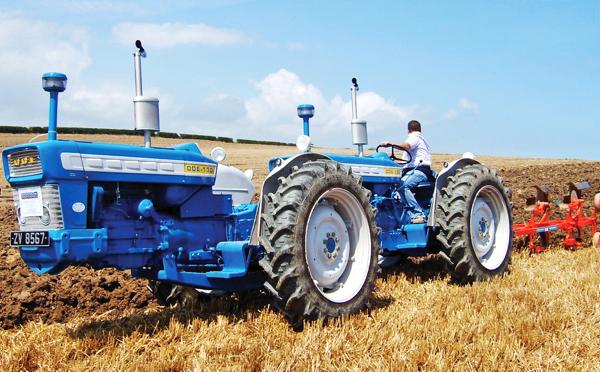Like its predecessors, the tractor was based on two Ford skid-units, in this case two 5000s from the company’s new 6X ‘Pre-Force’ range.
Each engine produced 65hp, hence the model’s ‘130’ designation. The tractors were joined together using a circular turntable, and initially steered using a dual hydraulic ram and orbital valve system, later replaced by the more traditional quad ram design of earlier DOE machines when it became apparent that the new set-up was prone to failure.
The DOE 130 was one of the last tandem design machines built by Ernest Doe and Sons Limited, a company that had held a Fordson dealership since 1956.
The tractor was the brainchild of George Pryor, an Essex farmer and friend of Ernest Doe. Pryor had encountered two issues with the tractors of the era, namely a lack of power and traction. By joining two Fordson Major E1As together, both problems were solved simultaneously.
Ernest Doe, recognising the commercial opportunity presented by Pryor’s design, decided to put the tractor into production as the ‘Doe Dual Drive’ or ‘Doe Triple D.’ Power Major, Super Major and New Performance Super major based Doe tractors soon followed as each new model was launched by the Fordson Company.
Driving a DOE tractor is certainly an experience, with the machine’s reaction to steering inputs, in particular, taking some getting used to!
Instead of the front tractor simply turning left or right, both the front and rear machines pivot on the central turntable to achieve the desired overall direction. The view from the driver’s seat is also an unusual sight with the end of front tractor’s bonnet appearing as far away as the horizon!
As the front unit was used to pull the rear along, its engine was set to run at higher revs. However, it is common to find that the rear power plant will have recorded more hours of work as the front tractor’s engine was often switched off when not required.
By the time the DOE 130 had arrived, gears were selected using a hydraulic master cylinder and slave assembly. The initial DOE prototype used linkages, which wore out over time resulting in selection problems.
The rear power unit controlled the machines’s hydraulics, often aided by an assistor ram.
Ernest Doe and Sons supplied a toolbar and tool carrier for use with the company’s range of implements, the most popular of which was the semi-mounted steerable plough. However, the eight-furrow plough produced by the firm was arguably the most impressive in action!
Approximately 70 DOE 130 tractors were built, the last of which was sold to the machine’s inventor, George Pryor. The machine was superseded by the DOE 150 which was based on the new 75hp 6Y Ford 5000 ‘Force’ tractor launched in 1968. However, it is believed that very few examples were produced.
As mainstream tractor manufacturers developed more powerful machines with four-wheel drive systems, demand for DOEs declined significantly. The last tandem machine produced by the company was the DOE 180, built using two Ford 7000 skid-units.
The last tractor manufactured by Ernest Doe and Sons Limited was the two-wheel drive DOE 5100, based on the 6Y Ford 5000. Today, DOE tractors are highly sought after and have achieved some of the highest prices ever recorded at vintage tractor sales in recent years.
*robertkierans@hotmail.com






 This is a subscriber-only article
This is a subscriber-only article






SHARING OPTIONS: